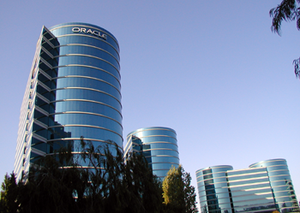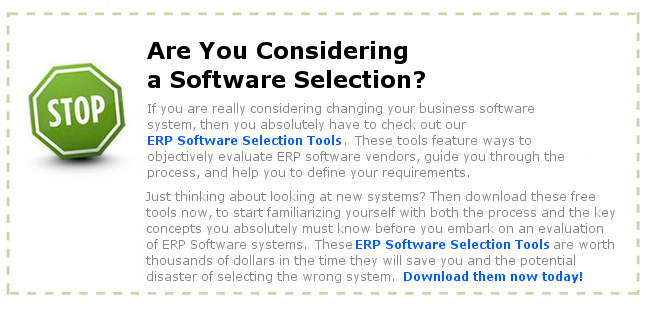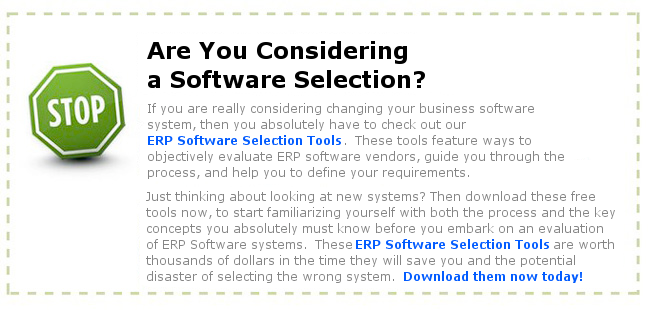[ReviewAZON asin=”B000MQ5LA6″ display=”fullpost”]
Tag: oracle
Video: Microsoft vs. SAP and Oracle’s mid-market offerings
How can Microsoft ERP compete with SAP and Oracle’s mid-market offerings?
Don Fornes, CEO of our partner Software Advice, interviewed the Microsoft Director of Marketing for ERP, Guy Weismantel, about the latest updates to the Microsoft ERP product line. In this video he talks about where and how Microsoft competes in the Enterprise with SAP and Oracle.
Often a corporate headquarters runs SAP or Oracle for the financials and the various plants, divisions and subsidiaries are running differing software, including Microsoft. Guy discusses the competitive advantages that Microsoft brings the these corporations at the divisional or plant level. There are some distinct advantages for these smaller segments of a large business to running Microsoft Dynamics. Find out more in this interesting video.
This is the fifth in a series of 7 videos that we will be posting.
Microsoft vs. SAP and Oracle’s mid-market offerings
Getting More Microsoft ERP Information
If you are interested in exploring Microsoft ERP for your company, please select one of the two links below:

For information on other ERP software products, please see our ERP Software Directory for many more vendors.
Microsoft ERP Channel Partners
For information on the Microsoft ERP Channel Partner Program, please see http://partner.microsoft.com
Insight into the Microsoft ERP Mix
When to use ERP Software Consultants
When to use ERP Software Consultants
Many times companies try to select and implement ERP software on their own. Sometimes this works and sometimes it doesn’t. So the question is, when should a company use an ERP Software Consultant to guide them in their ERP Selection or ERP Implementation?
The answer is not so simple. If a company is mature and has the resources that can look independently at the business processes, then it may make sense to embark on a selection on their own. Most of the time in mid-market sized or even smaller clients, then it is difficult for them to 1. Spare the resources and 2. Look at the business processes objectively.
Any good ERP Selection begins with a company evaluating their business processes. Borrowing from the Toyota Production system (aka Lean Manufacturing), a company should first eliminate waste and then consider automating. Automating bad processes will only make things worse faster. However, automating good processes will help grow the business and promote better communication.

- Image via Wikipedia
ERP Software Consultants – Best Practices
The real question becomes how much is the company willing to flex their processes to adapt to “best practices” that are usually built into a commercial software system. If the company is flexible (and this takes a lot of leadership to make happen), they can select a system and model their business around that system. The larger commercial systems, such as those from Microsoft, Infor, SAP, Oracle, and others have all grown up from thousands of implementations from all sorts of companies. They have developed efficiencies that many companies who adopt the software’s methodology can benefit from.
The real key is understanding the fit of a software package to the business. If the company does some niche processing, then a mainstream commercial package may not fit. However it the company is a distributor or a manufacturer of discrete products as an example, then a standard mid-market product would likely work for them.
So how do you choose the software, it is back to the business processes and the key requirements. “Key Requirements,” not just all requirements. The things that the old system does not do well and those things that it does very well are good places to start. Additionally, discover those requirements or processes that set your company apart from others in your industry. Usually processes around your competitive advantage are part of the key requirements.
Going back to the original question, should you use independent ERP Software Consultants? If you have a clear and objective understanding, you can afford the time to really research the vendors and you have a strong will with salespeople, then going it on your own might be reasonable.
If you do not have the time, the understanding of the ERP Software market, or the will power to manage at an arm’s length the software vendor’s salespeople, then an ERP Software Consultant would be a wise choice.
How to Negotiate and Purchase Your ERP System
ERP Negotiations Explained
There are many sources of information on how to select and implement software, but there is little information on how to negotiate and make the purchase of the software. The uninformed can spend thousands of dollars more than they need too by walking into ERP negotiations unprepared. Those that know the “tricks” of the trade can save themselves enough to pay for several modules or a good chunk of the implementation costs.
The first thing in ERP Negotiations to keep in mind is timing. When you buy the system timing is key. As this article is being written, the clock is ticking down to the end of the year. This is an opportune time to purchase a system. Even more advantageous is making the purchase at the end of the software vendor’s fiscal year. Vendors are hungry for the deal. The need to make the numbers for the year. They want to do whatever it takes to boost their sales figures and show a successful quarter. Actually, any quarter end will do, but year end is the time when bonuses are given and certain sales incentives are taunting the software salesperson.
The next thing to do in ERP Negotiations is to keep your options open. Even if you find the best whizzbang system that does exactly what you need, there are probably several systems that will work for you. Keeping your options open and communicating that to the salesperson will only make them work harder for the deal. Even if you know you will buy their software, let them know how much better or cheaper the competition is. Give them a reason to work for the deal.
ERP Negotiations around software pricing
When negotiating software pricing, keep in mind that you may not need all of the licenses up front. You can delay purchasing the entire suite of user seats until you are ready to go live. Get enough to cover your testing and implementation phases and be sure to lock in the pricing for a year or for the planned duration of the implementation.
Don’t forget that the implementation and how it will occur is negotiable. The terms of payment are negotiable. Who will be on the project from the vendor’s side is also a point of discussion and can be changed. There are many things that you can plan out and ask of the software provider or reseller.
Considerations for ERP Negotiations
Remember that most everything is negotiable. Software price, implementation rates, duration, and sometimes even annual maintenance contracts (those these are usually the most difficult). Perhaps negotiating when the maintenance begins will be possible. If you are splitting the user seats, have the maintenance pro-rated during the implementation phase.
Unlike the year 2000 preparations, there usually isn’t an absolute deadline as to when you need to purchase, so if you must, hold off for a month or two, if it is to your advantage. Or, tell the salesperson that you plan on doing so, so what can he/she do now?
Properly planned, the negotiation will more than pay for the time spent doing it correctly. Following the vendor’s lead will lead you to an overpriced system. Keep the money in your company’s bank, not the software company’s. Some negotiation strategies will work and some will not. The key is to remember that you are driving the sale. Get what you want at the price and terms that is fair to you.
Additional resources:
http://www.managingautomation.com/maonline/channel/exclusive/read/4063236
File as: ERP Negotiations
ERP Tiers: What Tier are you in?
ERP vendors and consultants are always trying to classify you as a company into distinct ERP tiers. What is your vertical industry? What is your revenue? How many employees? These are all questions of where you fit within their offering. Others talk about ERP Tiers. What are tiers? ERP Tiers are classifications of software by the size of the company the fit. Let’s break it down:
ERP Tiers: Tier 1 ERP
Tier 1 ERP software is software for the large enterprise. This includes multi-site, multi-national corporations. Typically the Tier 1 customer is a company with revenues in excess of $200 million dollars and has several sites, probably geographically dispersed and in multiple companies. There used to be what was known as JBOPS. JD Edwards, Baan, Oracle, People Soft, and SAP. Now that Oracle purchased People Soft, who had just prior purchased JD Edwards, the map has left the three primary ERP vendors: SAP, Oracle and Baan. These are your Tier 1 ERP players. Although not yet quite a Tier 1 ERP player, Microsoft with their Axapta (now called Dynamics AX) is pushing to be a Tier 1 software system.
ERP Tiers: Tier 2 ERP
The Tier 2 market is the largest of all the tiers in terms of the number of potential customers. This is the mid-sized tier. The customers of Tier 2 software usually are in the $20 million to $200 million dollars. They are usually just a few localized sites. For example a company that has a main office in California, with a manufacturing facility in Ohio and a distribution outlet in Texas would be a typical Tier 2 client. Often though, Tier 2 customers are single site. The main indication is the size of the company by revenue. This is important in that you probably will not find more than a couple hundred users all said and done. More likely though it is less than 100 users. Some references to the Tier classifcation refer to the number of employees. This is really not a good indicator as sometimes smaller companies with labor intensive processes may only have a few computer users.
Software in this class includes QAD, Infor’s Syteline, Microsoft Navision (Dynamics NV), ABAS, Glovia, Best’s MAS500, Epicor Vantage, and a host of others.
The problem that the Tier 2 vendors are facing is that the Tier 1 players are pushing down into this space. The market in the Tier 1 arena is small and to continue to expand their businesses, the Tier 1 players are reducing cost, simplifying transaction sets, and offering outsourced hosting and other incentives to allow a medium sized company to have the broad features of the Tier 1 package.
ERP Tiers: Tier 3 ERP
Tier 3 software is designed for single site customers of under $40 million dollars. These are companies with 5 to 30 users and have less demanding needs. Often these companies have just grown out of the Tier 4 packages and are looking to expand their capabilities. These companies tend to be the family run or small corporations.
Software in this market space includes Lily’s Visual Manufacturing, Intuitive Manufacturing, Microsoft Great Plains (Dynamics GP), DBA Software and Best’s MAS200.
ERP Tiers: Tier 4
Tier 4 software is your basic accounting systems. These include Peach Tree, Accpac and Quickbooks. This is the startup to $2 Million dollar software.
The next time you hear a vendor referring to a Tier 2 client, you will understand now that they are referring to a midsized company with just a couple plants. It is amazing how in the IT industry acronyms and categories spring up and every assumes they know what the other is referring to.
An interesting article is the segmentation of ERP into two tiers. You can read more in this publication: The rise of two-tier ERP: what it is and what it means.(TECHNOLOGY)(enterprise resource planning ): An article from: Strategic Finance
ERP Tiers
The Shrinking Landscape of ERP
Chris Shaul
Now that Oracle has gobbled up its competitors, Peoplesoft and JD Edwards, and has aquired Seibel CRM, there is a shrinking landscape of Tier 1 vendors available in the marketplace. It used to be the old JBOPS (JD Edwards, Baan, Oracle, Peoplesoft, and SAP) that people relied on as the playing field for their selections. Now, you have Oracle and SAP battling it out at the top end. SSA Software is working at bringing Baan back to the game under the name SSA ERP LN, but the market has not yet recognized the “new Baan”. So essentially there are now three players in the Tier 1 space.
SAP and Oracle are continuing to compete on the extensiblity of their solutions. SSA is making some buzz in the market too.
So the question is, will there be more variety or options, or will it be more of the same. If it is more of the same from each of these three players, then who will companies turn to? One possible answer in the future will be Microsoft and their Axapta (Now called Dynamics AX) product. But that product is still a few years from being a true Tier 1 competitor. The advantage with the Microsoft solution is very flexible technology that allows solutions and modifications to be built around the product core easily, without breaking the upgrade path. This flexibility outshines the other players. The depth of the product will be their in a few years, but it is not there yet.
What about the Tier 2 players? Can QAD, Epicor, or Infor produce a competing product? As of right now, no. It seems that is not the niche they want to play in. So for now, in the upper tier space, there will be only a few players and few options. But with everything in the IT world, a short time can reveal many new changes.
Chris Shaul is a Sr. IT Consultant and specializes about ERP selections and implementations.




